The biggest floods in Polish history. From Mieszko I to the flood of 1997 |
As large rivers such as the Oder and Vistula flow along the territory of Poland, floods have occurred on Polish lands since ancient times. The first historical mentions of a large water date back to the times of Mieszko I. However, the greatest losses were associated with the floods of 1934 and 1997, which are called the floods of the millennium.
History of floods in Poland
The first historical mentions of floods date back to the 10th and 11th centuries. Based on historical sources, we can reconstruct the years when Poland was hit by the greatest floods. In the Middle Ages, 15 floods were recorded in the years: 998, 1057, 1118, 1221, 1235, 1255, 1299, 1310, 1342, 1347, 1368, 1404, 1414, 1438, 1451, 1456, 1459, 1468, 1475 and 1493. In the modern period, Poland was hit by floods in: 1500, 1501, 1515, 1564, 1570, 1593, 1598, 1605, 1635, 1719, 1724, 1736 and 1774. In the 19th century, major floods in Polish lands occurred in: 1813, 1829, 1844, 1854, 1855, 1889 and 1897. In the 20th century, major floods occurred in: 1903, 1924, 1947, 1958, 1960, 1962, 1970, 1977, 1979, 1980, 1982, 1996, 1997 and 1998.
The oldest described flood in Poland is from 998 or 1097?
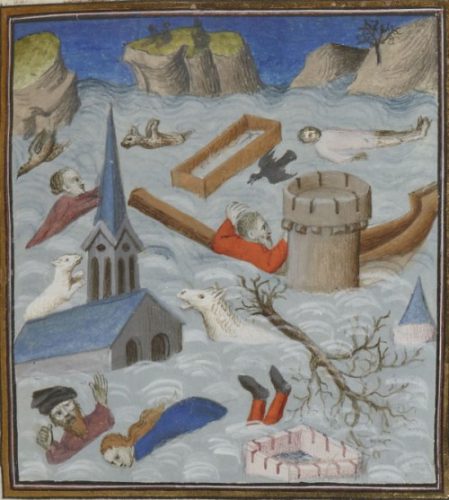
Flood in the Middle Ages / photo: Bibliothèque nationale de France
In the Annals, or chronicle of the famous Kingdom of Poland, Jan Długosz included only one entry under the year 988. This one concerned a great flood. Since the chronicler considered it appropriate to include such a record, one should suspect that he must have come across it in one of the sources that formed the basis of his work. It was probably a German source, so we cannot be certain that in 988 Mieszko I also struggled with this element in his duchy. Nevertheless, Długosz wrote that there were frequent and long-lasting floods that year. Additionally, the summer was so hot that the drought destroyed or reduced the crops. The catastrophic picture of 988 is also complemented by the heavy snows and autumn rains described by Długosz, which delayed the sowing.
If, due to the doubts cited, it is assumed that the described flood of 988 did not concern the lands of the Polans, then the oldest described flood in Polish lands is the flood of 1097. On that date, Długosz wrote that "a great flood prevented sowing, which resulted in a widespread crop failure."
The flood in Poland in 1118 stopped Krzywousty from waging war
Długosz definitely described the flood of 1118, i.e. during the reign of Bolesław Krzywousty, much better. Additionally, the flood of 1118 is a cataclysm that influenced the course of history. During the preparations for the expedition of the Polish prince Bolesław against the Pomeranians, Poland was hit by torrential rains. As Długosz writes, they began in the spring and lasted until the summer. That is, at a time when it is best to wage war. Additionally, the constant rains caused a flood "the likes of which have never been remembered". There was so much rain and water that it was impossible to sow the fields and harvest crops. The cities surrounded by larger rivers that overflowed their banks suffered the most. Presumably, these could have been Kraków, Wrocław, Głogów, Poznań, or Płock. As Długosz sums up, "there were such downpours and storms and finally such flooding of the rivers that some feared a second flood". As a result, Krzywousty had to postpone the trial with the Pomeranian Duke Świętopełk until another year.
Read also → Floods in Medieval Poland (10th to 14th centuries)
Flood in Poland in 1475. Great water in Krakow
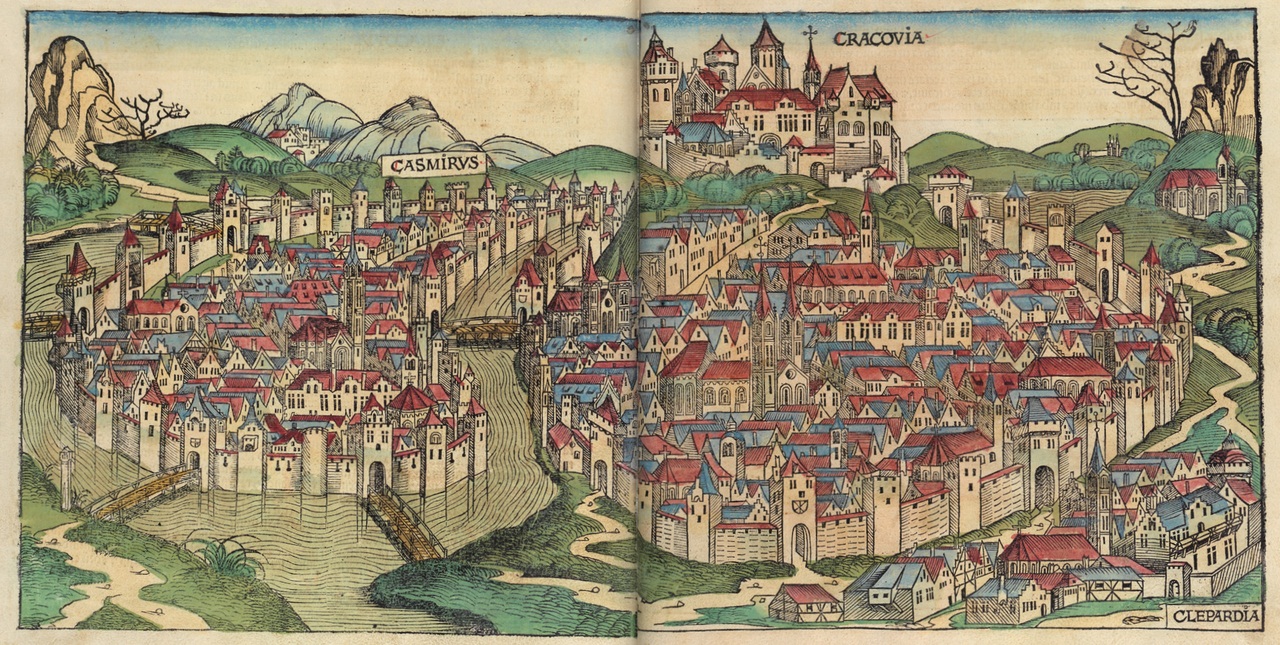
View of Krakow, Kazimierz and Kleparz in 1493. Visible bridges over the Vistula
The flood of 1475 was catastrophic, especially for Kraków. It took place during the reign of King Casimir IV Jagiellon. Its description is also perfectly documented by Długosz, as the chronicler was its direct observer. It is also one of the last entries in the Annals , which were written until Długosz's death, i.e. until 1480. As Długosz reported, from July 24, it rained for three days and three nights in a row. This led to "an unprecedented flooding of the Vistula in Kraków". The water also flooded Stradom and Kazimierz, which was then a separate city. In the Bernardine and St. Agnes Churches in Stradom, the water flowed up to the altars. It also tore off the bridge connecting Kazimierz with Kraków and other bridges around the walls of Kazimierz. As Długosz reported, "the water left behind a stench, from which many mortals died or weakened as a result of illnesses, some had swollen throats from drinking the water".
Another catastrophic flood hit Krakow two centuries earlier. In 1270, there was so much water that between Lasoty Mountain and the Church of St. Stanislaus on Skałka, the water carried away many people, causing much damage. Homes were destroyed, and the water took away farm animals and the property of many of the then residents of Krakow.
Flood in Poland in 1813. Krakow under water
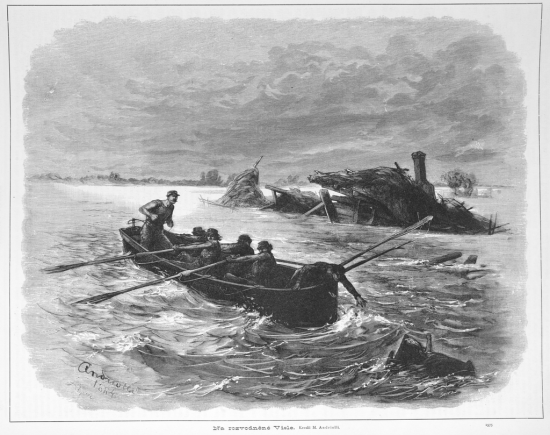
The Vistula River flood of 1813 depicted in an engraving by Michał Andriolli
In 1813, a flood hit Hungary, Poland, Germany and the Czech Republic. It was caused by a torrential summer, as well as the constant downpour from 26th to 29th August. This led to a rapid rise in water levels and the rivers bursting their banks. The flood wave was coming from the south to Kraków. Witness to the events and historian Ambroży Grabowski described that the Vistula flooded the entire Błonia, as well as the then villages of Ludwinów, Zakrzówek and Kapelanka. As Grabowski reported, "the area I am talking about seemed like a sea whose end could not be seen". Residents fleeing the elements sought shelter on Wawel Hill. Another witness to these events, Kazimierz Girtler, who noted in his diary that people sailed around Stradom on boats, and in the Bernardine church there was so much water that heavy wooden benches were floating on it. The water also destroyed the bridge between Kraków and Podgórze. "Such a great flood as in 1813 had not occurred for nearly two centuries since the time of Sigismund III. Ships with coal and wood took refuge under the Bishop's Palace," Girtler also described.
Flood in Poland in 1897. Great water in the Jelenia Góra Valley
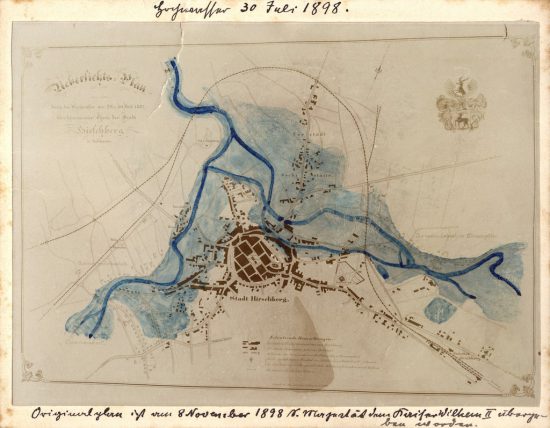
The area of flooded Jelenia Góra marked in blue during the flood in 1897 / photo: AP Wrocław, Jelenia Góra Branch
The flood of 1897 caused damage primarily in the Jelenia Góra Basin and the Karkonosze Mountains. The flood began with rains that fell on July 23 and 24. Locally, 200 to 400 mm fell (1 mm of precipitation = 1 l of water spilled on an area of 1 m2 ) . It did not rain for the next two days, but the rain returned on July 28. On July 29, there was a cloudburst, so large that the meteorological station in Nowa Łąka (Nová Louka, today the Czech Republic) measured a record one-day rainfall of 345.1 mm. This is still an unbeaten record in this part of Europe. That day, up to 150 mm of water fell in the Karkonosze Mountains. This caused many rivers and streams to overflow, including the Łomnica, Łomniczka and Jedlica, which led to the creation of a huge lake in the Jelenia Góra Basin. In Jelenia Góra itself, the area from Grunwaldzka Street to Krzywoustego Hill was flooded. Bridges in the city were torn off. On Grunwaldzka Street, the water reached the first floor. The water flooded hundreds of homes and dozens of factories, production halls and warehouses.
The element did not spare Kowary, Wleń, Cieplice and Sobieszów. In Kowary, the Jedlica River overflowed its bed, carrying even boulders and trees. Houses, service and industrial plants were destroyed. A porcelain factory was flooded. 21 bridges were also torn off and railway tracks were flooded, which severed communication with the city. In Wleń, water flooded the market square up to the first floor and remained there for three days.
After this catastrophic flood, it was decided to build a reservoir in Pilichowice in the years 1906-1912. It is home to the highest stone and arch dam in Poland. During its opening, a plaque commemorating the victims of the 1897 flood was unveiled. Additionally, regulation of the Jedlica River began. An anti-rubble dam was also built on the Łomnica in Karpacz. Flood embankments were built in Sobieszów and Cieplice.
Flood in Poland in 1934. The largest flood in pre-war Poland
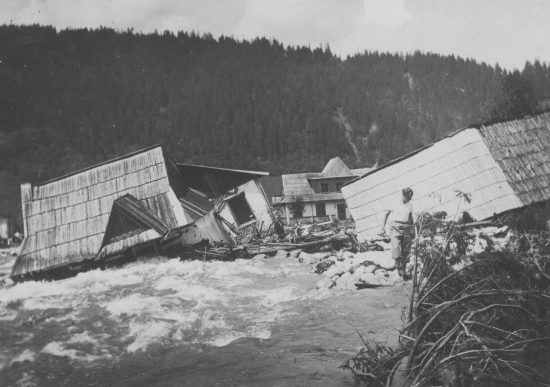
Flood in Zakopane, 1934
Until 1997, the flood of 1934 was undoubtedly the flood of the millennium. The great flood began with heavy rainfall that fell over Poland on July 13-17. The greatest intensity of rainfall occurred in Małopolska and there the effects of the flood were the most severe. On July 16, 255 mm of rain fell on Hala Gąsienicowa, which is a record that has not been broken to this day. Such rainfall increased water levels in rivers such as the Raba, Skawa, Wisłoka and Dunajec, which flooded on July 17. At many measuring stations, rainfall of 300 mm per m 2 was measured on July 16 and 17 .
The high water levels of these rivers also caused the Vistula to rise. A gigantic flood wave formed on this longest Polish river, which reached Warsaw on July 22, but fortunately did not cause any major damage in the capital. This was because before the water reached the capital, it had managed to overflow its bed and destroy flood banks in many places. This weakened its level. However, it had previously caused damage in Kraków, Zakopane, Skawina, Dobczyce, Nowy Sącz, Krościenko and Tarnów.
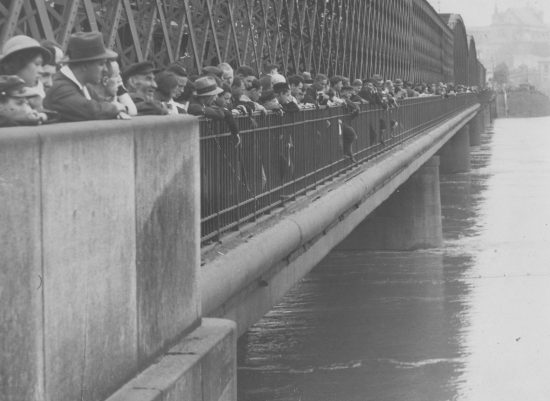
Flood in Warsaw in 1934. Varsovians from the now non-existent Kierbedź Bridge anxiously look at the level of the Vistula River
The flood of 1934 covered an area of about 1,260 km2 , killing 55 people. The economic losses were enormous. 22,000 buildings, 167 km of roads and 78 bridges were destroyed or damaged. The losses were estimated at about 12 million dollars, which would be worth about 250 million dollars today.
The flood resulted in investments being launched to prevent it from occurring in the future. A retention reservoir was built in Porąbka on the Soła River, and construction of a reservoir in Rożnów on the Dunajec River began, which was completed in 1941.
Read also → The winter of the century in 1929. At that time, Poland experienced record frosts and ran out of coal
Flood in Poland in 1947

A wooden high-water bridge over the Vistula River destroyed by a flood, Warsaw 1947
The cause of the first post-war flood was the exceptionally severe frost that occurred in Poland from November 1946 to March 1947. During that time, from mid-February, for a month, snow fell throughout the country. An additional factor influencing the extent of the flood was the post-war destruction of Poland, which also affected the flood protection infrastructure. Finally, there were many steel elements lying in the rivers, which were remnants of the war. They hindered the free flow of water.
The flood affected the inhabitants of the Sochaczew district the most, where 76 villages were flooded. In the Warsaw district, 26 villages were flooded. In the Poznań province, Nowy Dwór and Koło were completely flooded, and Konin and Poznań were partially flooded. In Wielkopolska, the flood caused major losses in agriculture. Around 50 thousand hectares of agricultural land and 50-70 thousand hectares of meadows and pastures were flooded. Around 2 thousand farm animals drowned there as well. The flood also destroyed 5 railway bridges, and another 26 road bridges were damaged. The great flood did not spare people either. During the flood, 55-75 people died. If the data closer to this higher number are true, then the flood of 1947 should be considered the most tragic.
As the authorities realized that some of the flooded villages were located in flood areas, a voluntary resettlement campaign was launched. For those willing, a new home was waiting in the so-called Recovered Territories. 714 families from the Warsaw and Sochaczew counties took advantage of this option. They were mainly relocated to the Olsztyn and Gdańsk provinces.
Flood in Poland in 1979
The winter of 1978/1979 is referred to as the winter of the century. A record amount of snow fell in Poland at that time. The snow cover in many places in the country reached previously unheard of levels. This huge amount of snow caused a meltwater flood when giant snowdrifts began to melt throughout the country. Additionally, the still frozen ground was unable to absorb the falling water, which instead of soaking in, flowed away, creating floods or causing rivers to overflow their beds.
The flood covered an area of about 20 thousand km2 of Poland. In many places, flood embankments were breached. The worst situation was experienced by towns in the basins of the Narew, Bug, lower Vistula, Noteć, as well as the Ina and Rega. The flooding of Pułtusk is a symbol of the enormity of the disaster in 1979. In this city, flood embankments were breached on April 5, as a result of which 1/3 of the city was flooded. Ostrołęka, Stargard and Koło, among others, also suffered.
Flood in Poland in 1997. Flood of the millennium
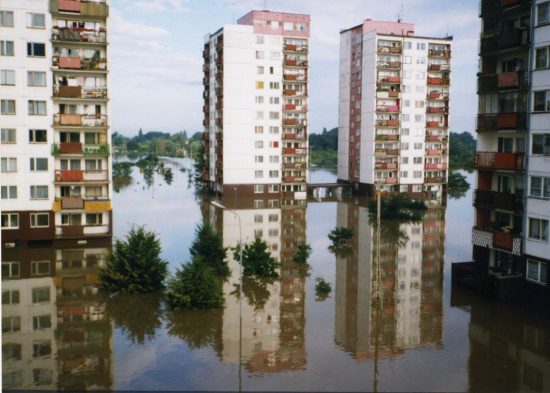
Flood in July 1997 in Wrocław. Kozanów housing estate / photo JMK Kokot, CC-BY-SA 3.0
In the memory of Poles living today, the flood of 1997 is the flood of the millennium. The great flood caused huge losses, especially in the west of the country. It was the last such a large flood that occurred in such a large area of Poland. However, the element was not limited to Poland. The Czech Republic, Germany, Slovakia and Austria were also flooded. In Poland, the flood affected primarily the Oder River basin.
The meteorological cause of the 1997 flood was the meeting of cold air masses from the Baltic Sea with warm air from the Black Sea and the Mediterranean Sea over Poland, which caused huge rainfall. From 4 to 8 July, 200 to 300 mm of rain fell in Lower Silesia, Silesia and Moravia. However, Łysa Góra (in Cieszyn Silesia) received as much rain in just 3 days. This means that in these places, as much water fell in a few days as usually falls in a period of 1-2 months. The first to be flooded were Prudnik and Głuchołazy, and in the following days also Wodzisław Śląski and Racibórz. The water caused huge losses in Kłodzko, where there was no scale on the gauge staff on the Nysa Kłodzka. The current of the flooded river was so strong that it destroyed several tenement houses.
The flood wave reached Opole on July 10 and flooded the districts of Zaodrze, Szczepanów and Półwieś. The flood embankment in the Metalchem district was breached, which caused the flooding of many industrial facilities. On Pasieka Island and Bolko Island, all buildings were flooded. The Old Town was saved with great effort.
Then the great flood reached Wrocław and flooded a huge part of the city, despite the fact that for two days the residents and services had been securing Wrocław by building embankments with sandbags. Some people took their cars to higher districts and gathered supplies of water and food. Despite this great generosity of the residents of Wrocław, on July 11 the water overflowed the embankments and in the early afternoon hours flooded Opolska, Katowicka, Bytomska, Chorzowska, Tarnogórska and Głubczycka streets. The next day the flood wave also flooded the city centre. The Main Railway Station was flooded, as well as numerous housing estates. We remember television reports from that period, which showed entire housing estates flooded. Many residents did not evacuate and remained at home. Food was delivered to such people by boats and helicopters.
Głogów was flooded. The railway line connecting Wrocław with Głogów was under water, which made communication on this section impossible.
The Vistula River experienced an incomparably smaller flood. This was due to the reservoir on Lake Czorsztyn, which weakened the flood wave. In Kraków, areas adjacent to the river were flooded, but the water did not cause as much destruction as in Lower Silesia.
In Poland, the flood claimed the lives of 56 people, and the losses amounted to a huge sum of PLN 12 billion. Around 7 thousand families lost their homes, and 9 thousand companies suffered significant property losses. 680 thousand apartments, 843 schools, 14.4 thousand km of roads and 2 thousand km of tracks were damaged. The water also tore off 45 bridges. It covered 6.65 thousand km 2 , or around 2% of the area of Poland.
Bibliography:
- W. Chudzik, The flood in July 1934 in Małopolska: socio-economic consequences , "Rocznik Lubelski", no. 40, 2014.
- B. Fal, The flood of the millennium?, "Knowledge and Life", 1997.
- S. Gacek, About floods in old Poland , "Mówią Wieki", no. 9, 1983.
- D. Jarosz, History of floods in Poland 1945-1989: prolegomena to research , "Studia i Materiały XII", 2014.
- D. Jarosz, G. Miernik, The flood of 1947: From research on the contexts of elementary disasters in Poland after World War II , "Annals of Social and Economic History 73", 2013.
- Z. Kowalewski, Floods in Poland - types, occurrence and protection system against their effects , "Water-Environment-Rural Areas", Vol. 6, no. 1, 2006.
- A. Majewski, The Vistula and its tributaries in the flood protection system in 1945-2000, Warsaw 2020.
- O. Muszkat, Floods in Medieval Poland (from the 10th to the 14th century) , historia.org.pl, https://historia.org.pl/2011/06/18/powodzie-w-sredniowiecznej-polsce-od-x-do-xiv-w/
- E. Pyzik, Floods in the Mysłakowice Commune and its vicinity , myslakowice.com, https://myslakowice.com/teksty,myslakowice,7,1,powodzie_myslakowice,26.html
- D. Riegert, Z. Ślosorz, K. Radwan, J. Rakowska, B. Porycka, I. Abgarowicz, P. Suchorab, Emergency protection methods used during floods with particular emphasis on flood sleeves , Józefów 2012.
- P. Stachnik, Kraków disappeared under water , "Dziennik Polski", 2014.
- How to cope with floods? Teaching materials for teachers , edited by M. Siudak, E. Tyralska-Wojtyczy, Kraków 2005.
You may also be interested in these articles:
The articles on the portal do not always present opinions consistent with the position of the entire editorial staff . We encourage you to discuss the content of the articles you have read. To do this, just provide your nickname and send a comment. You can also discuss our articles on our forum . You can also write your own article and send it to our editorial office .


And environmentalists don't want river regulation...
It doesn't work like that, if you regulate rivers, the water flow in the river accelerates. People build too close to rivers and this has disastrous consequences, for example, let's take the Kozanów housing estate in Wrocław, where apartment buildings are still being built there to this day. The government should give the river as much space as possible so that it can spread freely, which will reduce the force of the flood wave.
I guess apartment buildings weren't always built
Who asked? lol I'm going to do a somersault on my wheelchair Xdddd
but funny. come to dinner
Great article, but there is ambitious content on the internet.